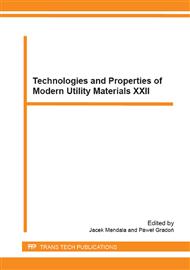p.87
p.91
p.95
p.99
p.103
p.107
p.111
p.115
p.121
The Causes of Low Impact Strength of T23 Steel Weld Joints
Abstract:
T23 is modern bainitic steel designed for use in supercritical boilers. According to producer’s data weldability of this steel is good enough to avoid post-weld heat treatment. However, some of the T23 weld joints in as-welded condition have not met the minimal ductility requirement. The impact test revealed significant differences between the joints in as-welded and heat treated condition. Metallographic and fractographic examinations have been conducted in order to explain those differences. The specimens with low impact strength were characterized by brittle fracture and non-tempered martensite presence in weld metal. It was concluded that avoiding formation of disadvantageous structure in weld metal requires conducting of post weld heat treatment or applying multi-pass welding technique with annealing run.
Info:
Periodical:
Pages:
103-106
Citation:
Online since:
January 2015
Authors:
Keywords:
Price:
Сopyright:
© 2015 Trans Tech Publications Ltd. All Rights Reserved
Share:
Citation:


